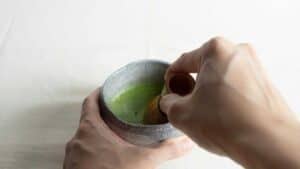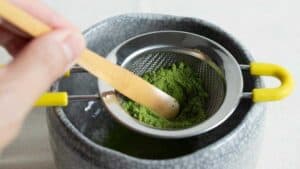One common problem that many tea drinkers complain about is the undissolved clumps of matcha powder that they encounter when drinking.
The problem lies entirely with the person making the tea. First, we need to understand that matcha is not like powdered milk or cocoa. In fact, it is not water-soluble. It is made from ground tea leaves, and the leaves are absolutely insoluble in water.
I believe many of you already have a solution, but this time I would like to share my solution with everyone.
- Take it and sift it.
This is arguably the best method. Matcha, which normally clumps together, becomes finer when sifted like flour, making it easier to mix with water. Furthermore, the texture of the tea is incredibly smooth and soft when you drink it. The only downside is that this method can be time-consuming and too meticulous when you’re in a rush.
- Mix a little bit of water together first.
If you’re too lazy to sift the matcha, you can fix this by adding water little by little. Add the matcha little at a time. Think of making pancakes. If you add everything at once and mix, the batter will be lumpy and it will take a lot of effort to mix it together. Matcha is the same. If you know how to make thick matcha (okoicha), you can use the same method. Scoop the tea powder into a cup, add a little hot water first, and use a brush to sweep left and right, knead it together. You will get a bright green mud-like substance like the one in the picture. After that, gradually add the remaining water.
- Use a matcha jar with a sifting lid.
This device is designed to solve this problem quickly and conveniently. It’s like a salt and pepper shaker on a table. However, there’s another problem: Matcha that has been exposed to moisture for a while and has formed clumps is very difficult to shake. Freshly unwrapped matcha will eventually have to resort to either method 1 or 2.
- Shake with a shaker
This is probably the easiest way to make matcha, especially when shaken with milk, which creates a lot of foam and is incredibly fine. The downside is that it can be difficult to shake to get any matcha lumps out, but at least the matcha lumps won’t be too big, they’ll be small and evenly distributed, so you can drink it without any problems. However, shaking with hot water or hot milk will cause steam to compress inside the bottle, making it splatter and making a mess when you open the lid. Also, be careful not to burn your hands.
- Mix with a milk frother
A foamer is a convenient tool for mixing matcha, but as mentioned in point 2, it’s still more effective to start mixing matcha with a small amount of liquid first.
- Mix matcha powder with sugar first.
If you want to add sugar to your recipe, mix the sugar with the matcha powder first. The easily dissolved sugar creates spaces for the matcha powder to separate easily without clumping.
- Use a matcha whisk to mix at high speed.
This last method is a method that relies on speed. In the case of using a matcha brush, your hands must be very steady. Use your wrist to move the brush up and down in a number 1 motion with the speed of a skilled guitarist plucking the strings. This technique requires experience, unless you are using a power-saving device like a milk frother or blender. In that case, I would recommend mixing with a small amount of liquid first, as it will be more finely ground.
In short, if you think of matcha as a flour, everything becomes much easier. You can use the same flour mixture you use when making desserts to mix matcha, and everything becomes much easier.
Article from: Vachi



